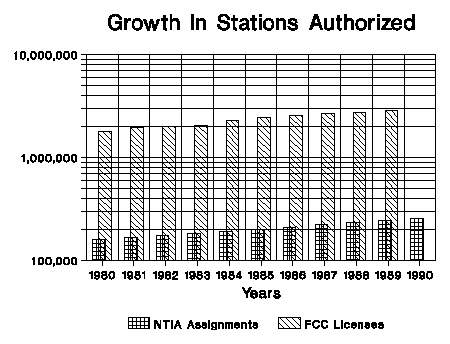There can be little argument that some form of coordination of operating frequencies and transmitting powers is necessary; after all, the present structure was developed largely because of the interference problems resulting from uncoordinated broadcasting and long-distance (High-Frequency) transmissions common during the first two decades of this century. However, unless the use of the spectrum is very heavy, there is no need to be overly concerned with how efficiently the spectrum is used. Thus, as long as the spectrum is plentiful, merely assuring that two users do not operate in the same part of the spectrum in the same area is sufficient. As the spectrum becomes more crowded, efforts to insure that the spectrum is used as efficiently as possible to maximize its availability to and use by all become more urgent.
At least until recently, advancing technology has always kept slightly ahead of the demand for spectrum. As demand for spectrum has increased, technology has developed radios that can perform the same function at higher unused frequencies or with decreased bandwidth at the same frequency. Now, demand for spectrum is growing rapidly, both from expanded use of current services like cellular radio, and the development of new uses, such as personal communications services (PCS), digital audio broadcasting, and advanced television (ATV). However, the technical advances needed to meet that demand may be "pushing the envelope" of practicality, at least in the short term. How much more can technologists compress signals to use increasingly crowded low frequencies, and how useful will the higher frequencies -- such as those above 20 GHz -- be for wireless communications?
The box below shows the rapid growth in the number of active frequency authorizations at both NTIA and the FCC since 1980. At NTIA, there were 61% more assignments active in 1990 than in 1980, while at the FCC there were 57.3% more licenses active in 1989 than in 1980. Thus, radio systems clearly are much more numerous today than they were in 1980. They have also become more complex during this period.

